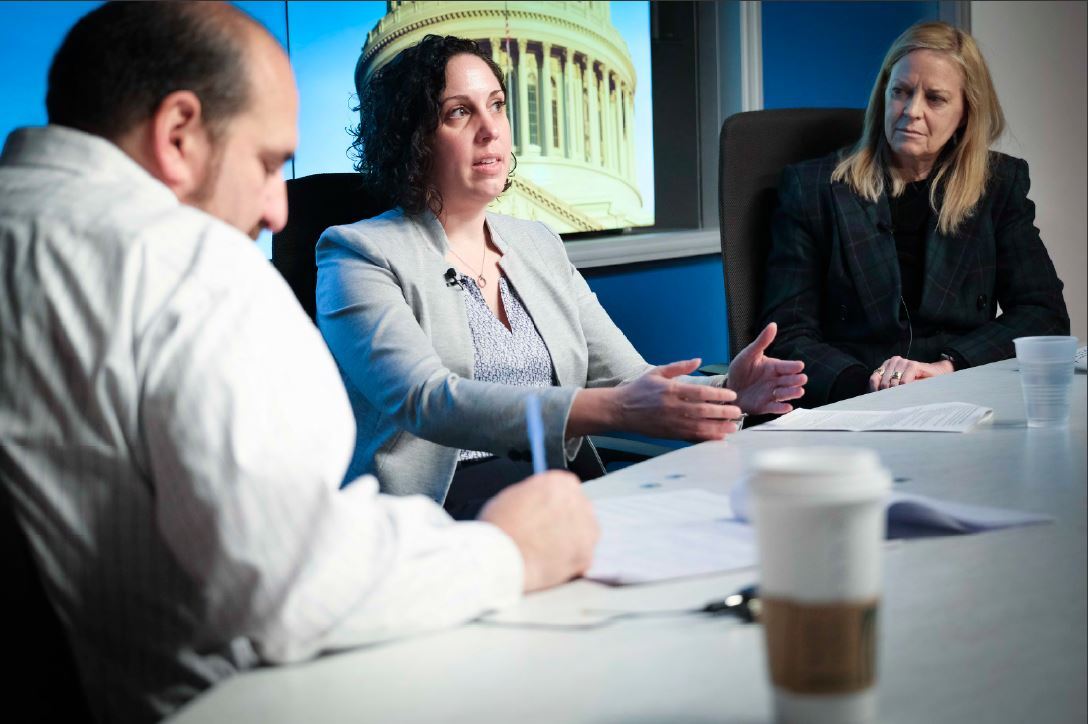

Judy Conley and Jessica McElman, of the Naval Surface Warfare Center Carderock Division, are both finalists for the Women in Technology leadership award for their...
Innovation doesn’t just happen at the Naval Surface Warfare Center Carderock Division.
It’s something that people like Judy Conley and Jessica McElman promote, encourage and demonstrate.
Conley, the science and technology coordinator for platform integrity, and McElman, the division head for underwater electromagnetic signatures and technology division at the Naval Surface Warfare Center Carderock Division, are both finalists for the Women in Technology leadership award for their efforts to ensure their employees don’t get stuck in a rut. WIT named 40 finalists across eight categories and will hold their 21st annual award ceremony on Oct. 29 — virtually.
“I’ve been very fortunate recently to work with the [innovation] lab at the Office of Personnel Management and with their human center design fundamentals. I’m helping them teach some of their fundamental courses,” Conley said. “That’s the thing we brought back to Carderock. How do you open yourself up to other people and when you are doing design actually do the ethnographics with people you are doing the design for, and doing the type of talking back and forth and working with prototypes side-by-side to get that tacit knowledge that doesn’t always come out.”

Conley, who has been with the Naval Surface Warfare Center Carderock Division for 38 years, said that also means working with employees to obtain their “latent” knowledge — things they do or know but can’t explain why they do it or know it.
“You can ask questions like ‘you turned the knob that way, why?’ They say, ‘I’ve always done it that way.’ But if they look back they may recognize why and that is powerful,” she said on Ask the CIO. “When you are going through and doing a design, it’s not just what you think they need. You have to go out there and talk to the sailors. I’m very fortunate to have been able to be in the field, and do a lot of things with them, see what their environment is like, talk to them about how they use things or how these things affect them.”
McElman, who has been with the division head for underwater electromagnetic signatures and technology division for more than two years, and who has been with the Naval Surface Warfare Center Carderock Division for 19 years, said the division’s staff works closely with sailors and others to address current systems and emerging needs.
“We’ve learned a lot along the way where we think we’ve done something good and they come back and say, ‘this is the part we hate the most.’ It’s very enlightening to get that type of feedback,” she said. “We are always looking to have integrated product teams (IPTs) or working groups where we bring in a wide variety of people with different backgrounds who can maybe provide different perspectives. The sailor on board, the program manager, the technical experts, the folks who think about logistics and operations because things that we do can affect each stakeholder differently.”
McElman said the role of any leader isn’t just to understand why a project or program is heading in a certain direction, but to make sure the engineers or acquisition or whomever also grasps the rationale for the ultimate goal.
Conley added this is why human-centered design is becoming more important for the Navy and for managers as a tool to be successful.
She gave sailors an app to provide feedback on flight operations tools.
“We brought in the actual people who were going to use it, the air bosses and landing signal officers, and got different perspectives about how they would use it and what was important to them. We were able to change it and get it out as a prototype,” Conley said. “We did that because we had the software developer sitting side-by-side with them as well as the project manager and the project engineer and seeing how that was powerful to have that information in the right way.”
Conley said she called the development of the flight operations tool a “pivot point” versus a failure.
“A lot of things we do should look at those pivot points and say how it didn’t work and how we can pivot to a different angle,” she said. “It’s really good to have that integrated team and have meetings where people see the big picture and their part within that big picture. Those have been the best projects because those things where you see the interaction is very important.”
Conley said it’s important to always be open to the different opportunities and not be afraid to change your approach and learn from those things.
McElman added there always are new ideas and new products to keep you and your staff motivated and ensuring you have an open mind will help not only keep the work exciting, but innovative too.
Naval Surface Warfare Center Carderock Division promotes innovation across all parts of the organization. In October, it launched the Rapid Innovation Center (RIC) that will let engineers and scientists experiment with software and hardware, and more rapidly transition these technologies to the fleet with little to no risk.
Copyright © 2024 Federal News Network. All rights reserved. This website is not intended for users located within the European Economic Area.
Jason Miller is executive editor of Federal News Network and directs news coverage on the people, policy and programs of the federal government.
Follow @jmillerWFED


